Do you have some questions about Dangerous Goods storage? Our Field Auditors regularly speak with customers across the country, answering their questions on the safe storage of Class 3 Flammable Liquids and other Dangerous Goods. So, we thought we’d share our answers to some of the most popular frequently asked questions including, ‘Do flammable cabinets need to be anchored?’
Read on to find out how you can solve your flammable liquids storage issues — and understand your obligations when it comes to chemical compliance.
FAQ #1 Where Should I Position My Indoor Flammable Liquids Cabinet?
Good question! Right out of the box, so to speak, your focus should be on positioning your flammable cabinet in a compliant location in your workplace.
Not only do you have to select a location that’s convenient for your staff to access the flammable liquids, but your organisation must also abide by the requirements of the Australian Standard AS 1940:2017.
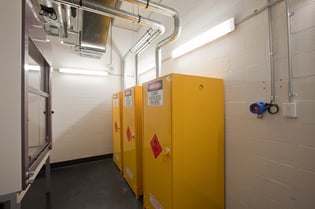 You must refer to the requirements of AS 1940:2017 when choosing a location for your flammable liquids storage cabinet.
You must refer to the requirements of AS 1940:2017 when choosing a location for your flammable liquids storage cabinet.
Let’s run through a few of the requirements, so you can decide on the best position for your cabinet.
The standard explains that:
- Flammable cabinets should be installed in a location that does not impede an emergency evacuation
- Aggregate capacities of flammable cabinets should not be greater than 850 L per 250 m2 on a ground floor area; or (ii) 250 L per 250 m2 on other floors.
- Aggregate quantities must be separated from each other by at least 10 m
- No ignition source will be located or come within 3 m of your flammable liquids
- An eyewash unit must be installed within 2 – 10 m of the cabinet if flammable liquids containers are opened anywhere near that location
- A safety shower must be installed if quantities of flammable liquids exceeds 2,000 L, it’s determined by a risk assessment, or there is a requirement under WHS Regulations
Do you have cabinets over 850 L in capacity?
The additional requirements for larger capacity cabinets include:
- Cabinets over 850 L must not be installed in buildings including hospitals, schools, aged care facilities, residential accommodation and commercial buildings
- Shall not be placed on a floor that doesn’t have direct access to ground level or the street
- Must not be located closer than 3 m to common walls — unless that common wall is made of concrete or masonry, and extends 3 m above the top of the cabinet and 3 m either side
- Your cabinet is installed on a flat, even surface
- The location provides easy access for staff
- The location also provides clear supervision for managers
- No cabinet should be located below a mezzanine level due to potential for impact damage of falling objects
REMEMBER: If the cabinet must be moved to a new location after the initial installation, you must ensure you’re meeting the cabinet installation requirements of AS 1940:2017. Don’t let unsupervised staff relocate a cabinet unless it’s been authorised by senior staff members who are trained in flammable liquids safety.
FAQ #2 Can I Store Other Chemicals In My Cabinet?
The short answer here is, ‘No’.
There are 9 Classes of Dangerous Goods, all with their own requirements for safe chemical storage. You should never mix classes of Dangerous Goods, as a violent chemical reaction is likely to occur.
 To maintain chemical compliance and workplace safety, you must understand how to successfully segregate Classes of Dangerous Goods.
To maintain chemical compliance and workplace safety, you must understand how to successfully segregate Classes of Dangerous Goods.
FAQ #3 I Have A Spare Flammable Cabinet. Can I Store Aerosols In It?
While you must always follow the Dangerous Goods segregation chart and separate incompatible substances, you can store Class 2.1 or Class 2.2 Flammable Gases (and only that Class of aerosols, as Class 2.1 and 2.2 must be segregated by 3 m) in an flammable cabinet.
Let me repeat that: You can store Class 2.1 or Class 2.2 aerosols in a flammable cabinet — as long as it doesn’t house any Class 3 Flammable Liquids or other Dangerous Goods Classes (as they’re incompatible substances).
Keep in mind, two things must happen before you make this change. The first is that the cabinet needs to be thoroughly cleaned, so there is no chemical reaction once the new goods are placed inside. Second is that the Dangerous Goods diamond on the cabinet must be swapped over to Class 2.1 or 2.2 before you load the cabinet.
As stated in Section 3.7 of AS 1940:2017, aerosols must always be kept in a store that has projectile protection. This is to prevent the aerosols becoming dangerous projectiles in the event of a fire.
A compliant flammable cabinet has already been constructed to provide projectile projection, so it can therefore be used to store either Class 2.1 or Class 2.2 gases. However, it’s always a preferably option to store aerosols in an aerosol storage cage that’s made for that Class of Dangerous Goods.
IMPORTANT: As gases provide no spill risk, we recommend that they’re stored in a purpose-built aerosol storage cage. A cage is engineered to meet the requirements of AS 4332:2004 – The storage and handling of gases in cylinders and provides protection for high pressure aerosol cans.
FAQ #4 Can I Store Combustibles Near Flammable Liquids?
Flammable liquids — such as paints, acetone, thinners, petrol and diesel — are volatile substance that can easily ignite in the presence of an ignition source.
As flammables can ignite at room temperature, they must be treated with the utmost care when they’re being handled, decanted, transferred or stored.
To reduce the risk of fire or explosion, combustibles should never be placed in a flammable liquids cabinet.
Combustibles should have their own designated storage solution — such as a filing cabinet for paperwork, or a dedicated cabinet for PPE.
Make sure that your staff don’t allow these types of materials in (or on top of) your flammable liquids storage cabinet:
- Excess packaging
- Paperwork
- Cleaning rags
- Dustpan and brushes
- Paintbrushes
- Uniforms
- PPE
Are you wondering where to store your Safety Data Sheets?
SDS storage or document storage boxes are specifically designed to provide the safe, durable storage solution for all your important chemical documents. You should attach a document holder to your flammable cabinet, so staff can quickly refer to your documents in the event of an emergency.
Whatever you do, don’t just leave these important documents lying around in your workplace. Not only are paper documents classed as combustible material, SDS must be easily accessible for all staff and contractors who deal with flammable liquids.
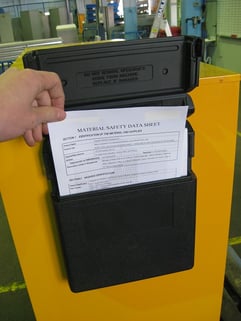 Your SDS are crucial documents that must be readily available to your staff. You should store these in a compliant document storage box that’s attached to your flammable cabinet.
Your SDS are crucial documents that must be readily available to your staff. You should store these in a compliant document storage box that’s attached to your flammable cabinet.
FAQ #5 Do Flammable Cabinets Need To Have Self-Closing Doors?
A compliant flammable cabinet is a risk control measure that’s been specifically designed and constructed to meet the requirements of AS 1940:2017.
In Section 4.9.4 of the standard, it explains that cabinet doors must be self-closing, close-fitting and held shut automatically by catches (at 2 or more points).
Therefore, your cabinet must have self-closing doors. But why?
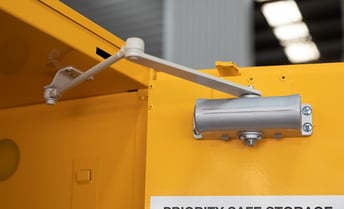 It is a requirement of AS 1940:2017 that flammable cabinets have self-closing doors.
It is a requirement of AS 1940:2017 that flammable cabinets have self-closing doors.
There are several reasons that flammable liquids cabinets must be constructed with self-closing, tight-fitting doors.
This specific risk control measures provides a range of safety benefits including:
- Flammable vapour containment
- Fire barrier (providing 10 minutes of protection during a fire)
- Assistance in reducing risk of chemical spills and leaks
- Protection from incompatible substances (see FAQ #2 for further details)
FAQ #6 Do Flammable Cabinets Need To Be Anchored?
The last FAQ that we’ll be answer in this blog, is one that’s quite simple to answer. If you are using an outdoor flammable liquids store, then we always suggest that you anchor your cabinet. However, this isn’t a requirement of AS 1940:2017 – it’s simply our team’s recommendation for risk reduction.
The reasons for this, is that outdoor flammable liquids stores may suffer impact damage from a range of sources in the outdoor environment.
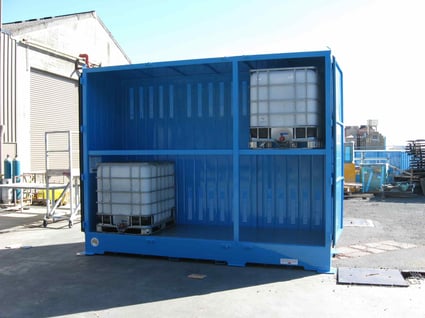
We recommend anchoring outside flammable liquids stores to avoid issues with cabinet instability.
Impact damage, such as a falling tree branch crashing onto your cabinet or a forklift running into your outdoor flammable liquids store, can cause serious cabinet damage and instability.
Outdoor cabinets are also exposed to the elements and may be subject to high winds.
By anchoring your outdoor flammable liquids store, you are reducing the risk of the cabinet toppling over or becoming unstable in the event of a storm, high winds or impact damage.
Our team at STOREMASTA construct flammable liquid stores that are already equipped with base plates. The cabinets can be easily bolted down and anchored to the spot — after you’ve decided on the right outside location.
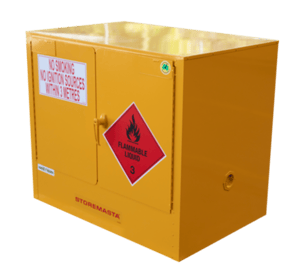 Unless it’s determined to be an essential risk control measure, you usually don’t have to anchor indoor flammable cabinets.
Unless it’s determined to be an essential risk control measure, you usually don’t have to anchor indoor flammable cabinets.
As indoor cabinets don’t face the same risks as outdoor stores, the only reason you may choose to bolt down your indoor safety cabinet is if it’s deemed a risk control measure during your chemical risk assessment. In a general workplace situation, you shouldn’t have to anchor your flammable liquids cabinet if it’s installed in a safe and compliant location indoors (see FAQ #1 for more information).
Any Further Questions About Flammable Cabinets?
If you’re still curious about how to correctly choose, install, set up and maintain a flammable cabinet, our team are here to help. We’ve also put together a helpful guide that will help you made the right decisions when you’re storing your Class 3 Dangerous Goods. Our eBook details everything you need to know about your compliance obligations. Get your free copy of Essential Considerations When Storing Flammable Liquids Indoors by simply clicking on the image below.
Joining the team as a Dangerous Goods Storage Consultant, Melissa Hampton became Storemasta's Marketing Manager in late 2021. With extensive knowledge and experience in chemical compliance, Melissa is responsible for leading the Marketing team and helping shape their marketing strategy. In her spare time, you can find Melissa hiking, swimming and enjoying the great outdoors in beautiful north-west Tasmania.
